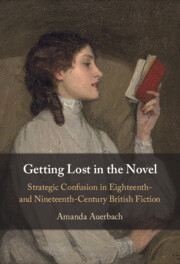Refine search
Actions for selected content:
27 results
Chapter 1 - A Sailor in the Family
-
- Book:
- Maritime Relations
- Published online:
- 23 August 2025
- Print publication:
- 04 September 2025, pp 18-59
-
- Chapter
- Export citation
Chapter 1 - Staging Consent
-
- Book:
- Manufacturing Dissent
- Published online:
- 03 October 2025
- Print publication:
- 21 August 2025, pp 16-57
-
- Chapter
- Export citation
Introduction
-
- Book:
- Getting Lost in the Novel
- Published online:
- 26 July 2025
- Print publication:
- 07 August 2025, pp 1-24
-
- Chapter
- Export citation
Chapter 2 - Getting Carried Away in the Victorian Bildungsroman
- from Part 1 - “Psychological” Subgenres
-
- Book:
- Getting Lost in the Novel
- Published online:
- 26 July 2025
- Print publication:
- 07 August 2025, pp 54-88
-
- Chapter
- Export citation

Getting Lost in the Novel
- Strategic Confusion in Eighteenth- and Nineteenth-Century British Fiction
-
- Published online:
- 26 July 2025
- Print publication:
- 07 August 2025
7 - Beyond the Demand for Narrative: Genres of Refugee Testimony
-
- Book:
- Judging Refugees
- Published online:
- 15 March 2024
- Print publication:
- 28 March 2024, pp 136-153
-
- Chapter
- Export citation
Chapter 3 - The Motion Picture Industry’s Coming of Age
-
- Book:
- Classical Hollywood, American Modernism
- Published online:
- 04 January 2024
- Print publication:
- 18 January 2024, pp 84-112
-
- Chapter
- Export citation
Matsotsi: The Migrant Detective and the Postcolonial State
-
- Journal:
- Cambridge Journal of Postcolonial Literary Inquiry / Volume 11 / Issue 1 / January 2024
- Published online by Cambridge University Press:
- 15 December 2023, pp. 1-18
-
- Article
-
- You have access
- Open access
- HTML
- Export citation
Chapter 9 - Clones and Other Sorrows
- from Part IV - Genome Time
-
- Book:
- Literature, Science, and Public Policy
- Published online:
- 03 August 2023
- Print publication:
- 17 August 2023, pp 182-197
-
- Chapter
-
- You have access
- Open access
- HTML
- Export citation
2 - Colonial Adventure Novels
-
-
- Book:
- The Cambridge History of the Australian Novel
- Published online:
- 28 June 2023
- Print publication:
- 27 July 2023, pp 28-43
-
- Chapter
- Export citation
2 - Picaresque Movements
- from Part I - The Silver-Fork Novel and the Transient World
-
- Book:
- Fashionable Fictions and the Currency of the Nineteenth-Century British Novel
- Published online:
- 11 May 2023
- Print publication:
- 25 May 2023, pp 91-126
-
- Chapter
- Export citation
Chapter 8 - Surrealism’s Anti-Bildungsroman
- from II - Transgression and Excess
-
-
- Book:
- A History of the Surrealist Novel
- Published online:
- 02 February 2023
- Print publication:
- 16 February 2023, pp 137-151
-
- Chapter
- Export citation
Chapter 7 - An Anglo–German Expatriate–Citizen
-
- Book:
- Victorian Women Writers and the Other Germany
- Published online:
- 02 June 2022
- Print publication:
- 09 June 2022, pp 162-186
-
- Chapter
- Export citation
Chapter 3 - Nabokov’s Supranational Metonymy
-
- Book:
- The Late Modernist Novel
- Published online:
- 02 June 2022
- Print publication:
- 09 June 2022, pp 94-118
-
- Chapter
- Export citation
3 - Imagining Ottoman Dandies and Industrious Effendis
-
- Book:
- Inventing Laziness
- Published online:
- 10 December 2021
- Print publication:
- 09 December 2021, pp 147-193
-
- Chapter
- Export citation
Chapter 19 - Gender, Biopolitics, Bildungsroman
- from Part IV - Society
-
-
- Book:
- British Literature in Transition, 1900–1920: A New Age?
- Published online:
- 07 December 2021
- Print publication:
- 02 December 2021, pp 346-364
-
- Chapter
- Export citation
Chapter 3 - Context
-
- Book:
- The Cambridge Introduction to Mikhail Bakhtin
- Published online:
- 21 October 2021
- Print publication:
- 04 November 2021, pp 30-58
-
- Chapter
- Export citation
12 - Dissolution
- from Part III - Themes
-
-
- Book:
- The Cambridge Companion to Twenty-First Century American Fiction
- Published online:
- 02 September 2021
- Print publication:
- 23 September 2021, pp 234-250
-
- Chapter
- Export citation
Chapter 2 - Asian American Realism
- from Part I - Transitions Approached through Concepts and History
-
-
- Book:
- Asian American Literature in Transition, 1930–1965
- Published online:
- 27 May 2021
- Print publication:
- 17 June 2021, pp 38-54
-
- Chapter
- Export citation
Postscript - Further Targets for Historical Research
-
- Book:
- Development
- Published online:
- 10 June 2021
- Print publication:
- 10 June 2021, pp 205-207
-
- Chapter
- Export citation
